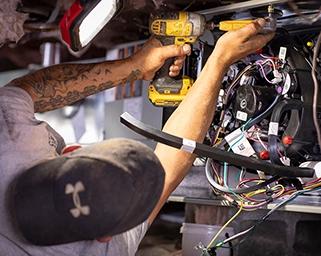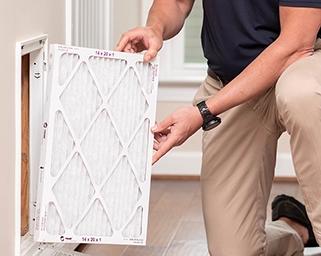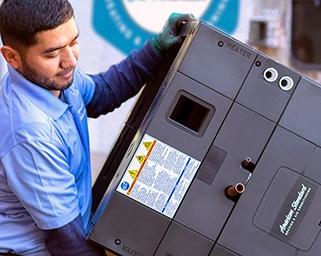6 Tips to Save Money and Lower Your Heating Costs This Fall and Winter
By implementing a few energy-saving tricks, such as installing a smart thermostat or increasing insulation levels, you can lower monthly heating costs.

By Tom Moor
As temperatures drop in the colder months, heating costs usually rise. In fact, homeowners in northern regions often see monthly heating expenses soar well over $100. The good news is that a few simple strategies can help lower those costs this fall and winter, keeping more of your hard-earned money in your wallet. Here’s how.
How to lower your utility bills this winter
#1: Adjust your thermostat appropriately
Most homeowners enjoy a warm, cozy home when it’s frigid outside. But setting the thermostat too high causes your furnace, heat pump, or boiler to work overtime, leading to higher energy expenses.
A good rule of thumb is to set your thermostat to 68°F while at home and 60-64°F while you’re away or asleep. According to the U.S. Department of Energy, adjusting your thermostat by 7-10 degrees for at least eight hours each day can save you up to 10% a year on heating and cooling costs.
If those adjustments feel too chilly, start by lowering the temperature just a degree or two at first, and consider layering with blankets to stay comfortable.
#2: Upgrade to a smart thermostat
No one wants to adjust their thermostat all day. Let a smart thermostat do the work for you. Like a programmable thermostat, smart units allow you to pre-set temperatures based on the time of day and day of the week, so it automatically lowers the setting before you go to bed or leave for work. Over time, many models even learn your habits and adjust automatically.
On average, a smart thermostat can trim about 8% off your heating and cooling costs – or roughly $50 a year
#3: Keep your furnace maintained
It’s smart to have your heating equipment professionally serviced once a year, preferably in the fall before you start relying on it. During a furnace or heat pump tune-up, an HVAC technician replaces or cleans air filters, lubricates moving parts, tests safety features, and checks electrical components to ensure everything is operating smoothly and safely. This keeps your system running effectively, helps lower monthly bills, and reduces the chance of surprise breakdowns.
#4: Seal drafts
Even the tiniest openings can allow cold air to sneak into your home. Sealing gaps around doors and windows with weatherstripping or caulk is an easy way to keep cold air out and prevent your furnace from working harder than necessary.
Sealing gaps in your home's air barrier can lower heating and cooling costs by as much as 15-20%, according to the U.S. Environmental Protection Agency.
#5: Check insulation levels
Adequate attic insulation is one of the best defenses against cold air infiltration during the fall and winter. Unfortunately, about nine in 10 homes in the U.S. are under-insulated, according to ENERGY STAR.
To check if you need more insulation, watch for uneven room temperatures, drafts, or higher-than-usual utility bills. You can also inspect your attic to see if the insulation is level with or below the attic floor joists. If you notice any of these signs, it may be time to add more insulation to keep your home warm and energy efficient.
The U.S. Department of Energy estimates homeowners can save up to 20% on heating and cooling costs by adding insulation in basements, attics, and floors over crawl spaces.
#6: Upgrade your heating equipment
If your current furnace, boiler, or heat pump is old and inefficient, your energy expenses are likely to remain high even after implementing a few of these strategies. While replacing an HVAC system is a significant financial investment, upgrading to a modern, high-efficiency unit can reduce monthly utility bills and improve comfort throughout your home.
Today’s ENERGY STAR®-certified equipment uses far less energy than older models, often paying for themselves over time through lower operating costs. Many utility companies and federal programs also offer rebates or tax credits to help offset upfront expenses.
If you’re unsure whether it’s time for an upgrade, an American Standard® HVAC dealer can inspect your system and recommend whether HVAC repair or replacement makes more sense. To sum up, here are your potential savings.
| Energy Saving Tip | Potential Savings on Heating Costs |
| Lower thermostat 7-10 degrees for 8 hours | Up to 10% |
| Install a smart thermostat | About 8%, or roughly $50 per year |
| Seal gaps | 15-20% |
| Add more insulation | Up to 20% |
| Upgrade furnace or heat pump | Savings will vary based on the efficiency of the old and new systems |
Bonus Quick Tips
Here are a few more easy ways to save:
- Using ceiling fans in reverse: Switch your ceiling fan to spin clockwise at a low speed to push warm air back down into the room. Doing so can help keep rooms warmer at a lower thermostat setting. Just be sure to turn the fans off when you leave the room to avoid wasting electricity.
- Optimizing sunlight: Open blinds and curtains during the day to let in natural warmth. Make sure to close them at night to trap heat indoors and block out the chill from outside.
- Layering up: Wearing warmer clothing while inside lets you keep the thermostat a few degrees lower without sacrificing comfort.
- Keeping air vents clear: Make sure furniture, curtains, or rugs aren’t blocking vents so warm air can circulate freely.
Keep your home comfortable with American Standard®
Ready to lower energy costs and get the most out of your heating system? American Standard’s network of trustworthy, reliable dealers can provide expert maintenance, repair, and installation services to keep your heating system running properly all winter long.
Author: Tom Moor
Expert review by Eric Weiss, Training Manager I, Residential HVAC Services



